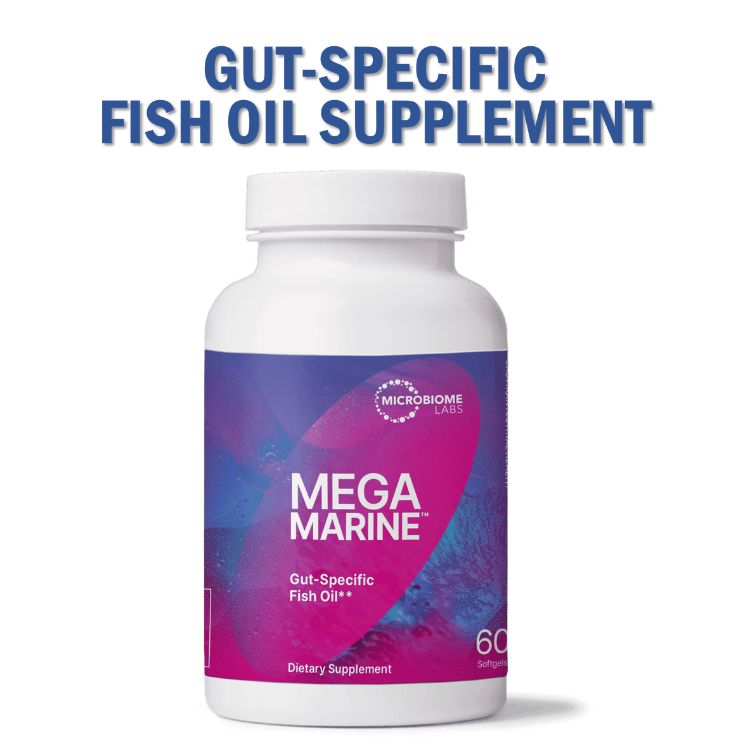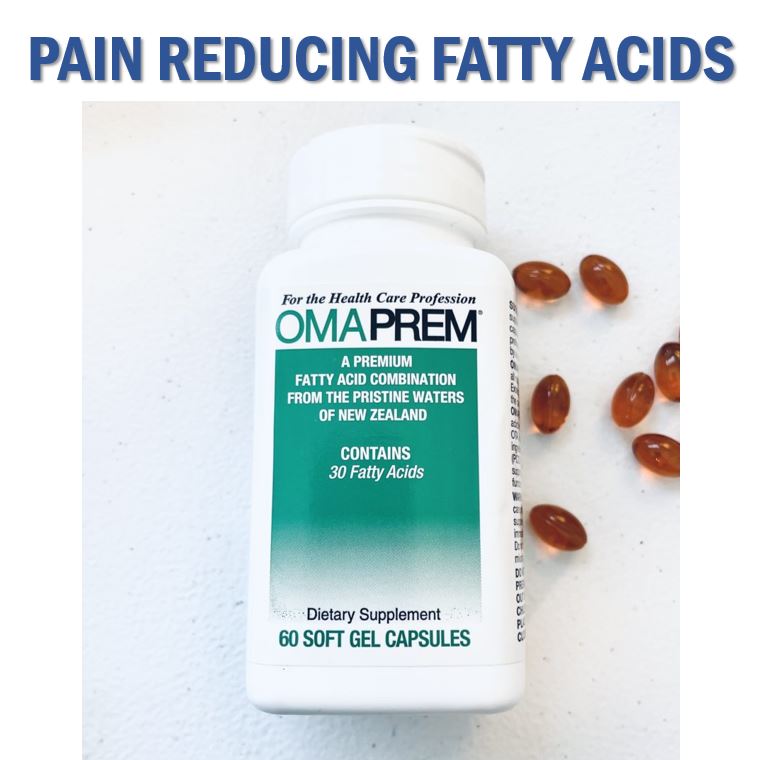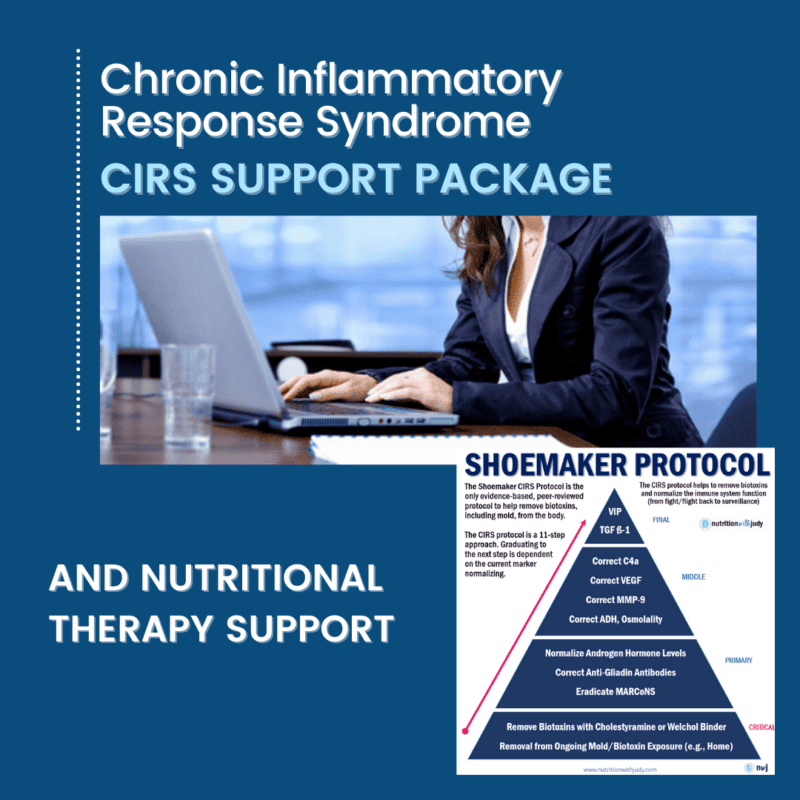

CIRS Blood Markers and Treatment


Chronic Inflammatory Response Syndrome (CIRS) is a multifaceted condition characterized by a range of symptoms and underlying biological markers that can be detected through blood tests. Understanding these CIRS blood markers is crucial for both diagnosing the condition and monitoring treatment progress, particularly when following the Shoemaker Protocol.
Let’s explore the key blood markers associated with CIRS, how they help in diagnosing the condition, and their role in guiding treatment decisions. Additionally, we will discuss various treatment options available to correct abnormalities found in these markers, offering insight into the comprehensive management strategies that are essential for those affected by CIRS.
By taking a closer look into the specifics of blood markers and their correction, patients can more effectively navigate the challenges of treating and managing CIRS.
What Is CIRS?
CIRS is identified as a complex medical condition marked by extensive inflammation and a broad range of symptoms affecting various organ systems, due to an overactive immune response. Diagnosing CIRS accurately involves a thorough review of the patient’s medical history alongside specialized laboratory tests. The symptoms associated with CIRS can differ significantly from one person to another, which frequently results in either misdiagnosis or incorrect treatment. A significant challenge in identifying CIRS lies in its non-detection through conventional autoimmune blood tests, thus requiring specific diagnostic methods for accurate identification of the condition.
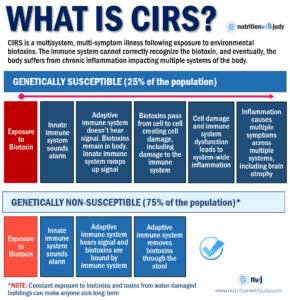

What are the primary factors that ignite the severe immune reactions and widespread inflammation seen in CIRS? The leading causes are biotoxins—natural toxic substances with distinct molecular weights that originate from various sources:
- Water-damaged environments: Around 80% of CIRS cases are linked to exposure to air in environments compromised by water damage, teeming with mold mycotoxins, bacteria, and a slew of chemical irritants. These contaminants trigger robust inflammatory reactions in individuals susceptible to CIRS, with both active and inactive mold components contributing to significant inflammation throughout the body and brain.
- Insect bites: Bites from specific ticks and spiders may cause ongoing health issues such as chronic Lyme disease, which are brought on by pathogens including Borrelia burgdorferi and Babesia microti. Additionally, toxins from recluse spider bites can cause long-lasting health effects.
- Seafood consumption: Eating tropical reef fish contaminated with ciguatera toxin, often associated with Pfiesteria and harmful algae blooms, such as cyanobacteria (blue-green algae), can lead to biotoxin-related health problems. These toxins build up as larger reef fish prey on smaller fish that have consumed dinoflagellates.
- Contact with contaminated water: Coming into contact with or inhaling water contaminated with toxic algae blooms, like Pfiesteria and cyanobacteria, can set off the inflammatory responses typical of CIRS.
- Other biotoxin sources: CIRS can also be triggered by exposure to certain vaccines, viruses, volatile organic compounds (VOCs), endotoxins, and actinomycetes, adding further to the body’s burden of biotoxins.
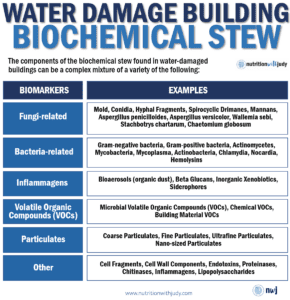

Due to their small molecular size, biotoxins can infiltrate cell membranes, making them difficult to detect in standard blood tests. These toxins typically enter the body through inhalation, although they can also be absorbed through ingestion, tick and spider bites, and direct contact with contaminated water.
Not all exposure to common biotoxins such as mold automatically results in CIRS; factors such as an individual’s genetic makeup and life stressors significantly influence their susceptibility to biotoxin-related conditions. Life events like severe illnesses, surgical interventions, high fevers, pregnancies, significant biotoxin exposures, and other traumatic incidents can provoke a cytokine storm. This immune reaction may activate the CIRS gene in those who are genetically prone, particularly in individuals with HLA-DR genes, suggesting that CIRS can arise at any point in life. Notably, the lack of symptoms does not mean one is immune, making genetic testing a vital component of preventive strategies.
While biotoxins may cause immediate sickness, most people’s immune systems are capable of detecting and eliminating these toxins efficiently. However, for those with a genetic predisposition to CIRS, their immune systems fail to recognize and clear these toxins, leading to their buildup in the body. This accumulation triggers a persistent, intense immune response and widespread inflammation, resulting in a variety of symptoms and chronic health issues.
The biotoxin pathway explains why CIRS is a multi-system, multi-symptom condition, you can learn more about the biotoxin pathway here.
For a more detailed understanding of CIRS, click here.
What Are the CIRS Blood Markers?


The first lab test needed is the HLA-DR which identifies the genetic susceptibility to CIRS. Please note, it is extremely rare to have CIRS if you do not have the haplotype. However, about 5% of CIRS cases are not in genetically-susceptible individuals. Working with a professional CIRS provider is best to help navigate this scenario in order to get proper treatment. HLA testing only needs to be completed once as a part of the CIRS diagnostic criteria.
In addition to the HLA-DR genetic testing, blood work for specific markers will be needed. These specific labs will be used for both diagnosis and monitoring clinical progress for CIRS. Be aware that different labs have different ranges for blood markers, making it important to have a trusted CIRS practitioner evaluate your results.
- MSH: Often referred to as the “master gland,” Melanocyte Stimulating Hormone (MSH) plays a critical role in regulating various hormonal and anti-inflammatory processes. It is observed that over 95% of individuals with CIRS exhibit low levels of MSH, a condition often influenced by the biotoxin pathway. This reduction in MSH heightens their sensitivity to mold toxins and can lead to a range of issues including sleep disturbances, gastrointestinal problems, mood fluctuations, hormonal imbalances, and other health concerns.
- TGF Beta-1: This crucial biomarker is essential in managing the innate immune system. The multifunctional protein is involved in regulating immune functions, cell survival, and cell migration. Elevated levels of Transforming Growth Factor Beta-1 (TGF Beta-1) are associated with a variety of health issues, including autoimmune disorders, neurological conditions, and other systemic complications.
- Complement C4a: C4a, a component of the complement system mentioned earlier, serves as a pivotal inflammatory marker for both diagnosing and monitoring CIRS. It reflects the innate immune response in individuals who have been exposed to water-damaged environments. This marker typically rises within 12 hours following acute exposure. During the treatment process, levels of C4a are observed to decrease rapidly once the individual is no longer exposed to the harmful environment.
- MMP-9: This enzyme plays a critical role in the breakdown of disease and various tissues under normal physiological conditions. Elevated levels of matrix metalloproteinase-9 (MMP-9) contribute to tissue damage within the walls of blood vessels, which in turn can cause inflammation in the brain, lungs, muscles, joints, and peripheral nerves.
- VEGF: VEGF, or Vascular Endothelial Growth Factor, is crucial for promoting the growth of new blood vessels, enhancing blood circulation, and facilitating the delivery of oxygen and nutrients throughout the body. When VEGF levels are diminished, it can result in insufficient blood flow and cellular deprivation, which are significant and frequent complications associated with CIRS.
- VIP: Vasoactive Intestinal Polypeptide (VIP) is a neuropeptide crucial for controlling cytokine responses, managing pulmonary artery pressures, and moderating inflammation throughout the body. Patients with CIRS commonly exhibit low levels of VIP, which can cause symptoms such as shortness of breath during physical activity and contribute to conditions such as diarrhea. VIP functions similarly to MSH in its regulatory effects on inflammatory processes.
Many other blood markers often become dysregulated by CIRS. Additional markers are usually tested initially to get a better understanding of all the downstream impacts caused by chronic, systemic inflammation. They may be tracked throughout treatment as well for resolution. You can learn more about some of these other impacted blood markers here.
However, these are the necessary markers needed for diagnosis and are more commonly tracked throughout treatment.
Pro-Tip: Always track VCS and symptom clusters. Your symptoms should dictate a lot of treatment. We don’t recommend just chasing numbers on blood work. Testing blood markers every three to four months is ideal but often varies from case to case.
Correcting CIRS Markers
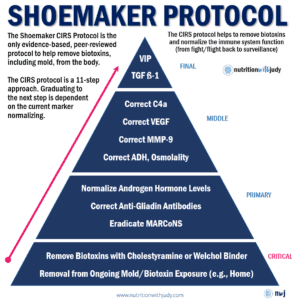

The Shoemaker Protocol is designed to correct these abnormal markers in CIRS patients. While certain steps can be more impacted for normalizing particular markers, others may need additional support. Let’s take a closer look at some of the treatments available for correcting the key CIRS blood markers above.
MSH
The release of this neuroregulatory hormone is controlled by leptin in the pituitary. With CIRS, disruption of the leptin receptor from an increase in cytokines causes a drop in MSH, a master controller of many functions in the body. Low levels of MSH lead to dysregulation of multiple processes, causing:
- Problems with sleep patterns and melatonin, leading to disturbed sleep
- Problems with salt and water balance through its interaction with antidiuretic hormone (ADH)/arginine vasopressin (AVP) and serum osmolality, leading to increased thirst and urination, heart palpitations, and POTS
- Dysregulation of the immune system with increased inflammatory cytokines, T-cell abnormalities, and an increase in autoimmunity
- Increased pain due to decreased endorphin production
- Issues with increased gut permeability
- Reduction in androgens/low testosterone
- Colonization of the nose with MARCoNS
- Weight gain that’s unresponsive to changes in diet and exercise due to leptin dysregulation
Vasoactive Intestinal Peptide (VIP) is a peptide hormone that exerts a profound anti-inflammatory and immunomodulatory effect. Low VIP levels are commonly observed across CIRS patients as one of the downstream effects of the biotoxin pathway. As the last step of the Shoemaker Protocol, VIP Intranasal Spray can help correct low MSH levels.
Theoretically, there may be some natural treatment options for boosting low MSH levels. These treatments have yet to be fully researched but may be considered as additional supportive levers. These natural options and potential alternatives to VIP Intranasal Spray can be found in our CIRS Support Group.
Pro-Tip: Low-dose VIP may be used during different parts of the Shoemaker Protocol to help sensitive patients better tolerate binders, treating MARCoNS, or other potential roadblocks experienced in treatment. Some food sensitivities can be improved with diluted VIP. VIP can flare histamines, making it important to speak with your trusted CIRS practitioner if you struggle with histamine or mast cell activation issues. For individuals starting VIP as the last step of the Shoemaker Protocol, you must pass the following criteria: 1) MARCoNS must be eradicated, 2) pass the VCS test, 3) lipase is normal, and 4) must be out of exposure.
TGF-Beta 1
Elevated TGF Beta-1 indicates an overactive immune response and is a key marker for CIRS. It can change regulatory T cells into pathologic T cells, further driving inflammation. It may also cause tissue remodeling in multiple tissues in the body. Correcting TGF Beta-1 is important due to the potential for long-term tissue changes.
It is important to note that many various factors can cause elevated TGF Beta-1 outside of CIRS. Blood markers should always be interpreted together along with the specific context of each patient’s case.
In some cases, TGF Beta-1 will normalize on its own once a CIRS patient is out of exposure and on Cholestyramine (CSM) or Welchol, the prescription binders for CIRS, for an adequate amount of time. If TGF Beta-1 has not corrected on its own, step 10 of the Shoemaker Protocol addresses this. The final step of the Shoemaker Protocol utilizes Vasoactive Intestinal Peptide (VIP) Intranasal Spray which can also help correct elevated TGF Beta-1.
We recommend trying natural support options for correcting TGF Beta-1 first before trying the prescription option called Losartan. For a comprehensive list of natural supports and their specific protocols, please join our CIRS Support Group. Always work with your trusted CIRS practitioner to create the best-personalized treatment protocol for your case.
Complement C4a
The activation of the complement system plays an important role in our natural ability to ward off infection in addition to the pathogenesis of infection and inflammation. The complement cascade activation results in the formation of complement split products C3a, C4a, and C5a.
Complement C4a levels can become increased in any condition associated with inflammation. There are three general pathways by which the body increases C4a: the alternative pathway, the lectin pathway, and the classical pathway. These pathways are activated by infections, including bacteria, fungi, viruses, and parasites. Immunoglobulins (IgG, IgM) and C-reactive protein (CRP) can also increase C4a.
C4a appears to be an immune marker with elevated levels in the following disorders:
- CIRS
- Lyme disease
- Chronic Fatigue Syndrome
- Psoriasis
- Eczema
- Antiphospholipid syndrome
- Lupus (low levels of C4a)
- AIDS
- Schizophrenia
- Acute pancreatitis
Similar to TGF Beta-1, C4a may also correct on its own. In the context of CIRS, C4a can be directly tied to biotoxin exposure. Having C4a levels normalize during the Shoemaker Protocol can often indicate that the patient is out of exposure.
In addition to getting out of exposure and managing excess histamines, VIP Intranasal Spray during the last step of the Shoemaker Protocol can also help correct elevated C4a levels. Daily movement, high-quality fish oils, and specialized pro-resolving mediators (SPMs) are additional natural supports for helping reduce elevated C4a.
MMP-9
White blood cells that are activated by macrophages can activate the enzyme MMP-9 which creates holes in the basement membranes of endothelial cells, allowing inflammatory compounds to penetrate into bodily tissues. This is an important normal function of the immune system so that inflammatory “helpers” can get to the sites of inflammation. However, with a continuous stimulus such as biotoxins, this becomes destructive.
High MMP-9 will increase the blood-brain barrier permeability.
Elevated MMP-9 is another marker that may resolve on its own during the Shoemaker Protocol. We recommend trying natural supports such as high-dose fish oils, SPMs, and a high-fat carnivore diet before trying the prescription medication option. The prescription option contains a Black Box warning and should only be used as if all other natural alternatives have been exhausted.
VEGF
VEGF is a cytokine that stimulates new blood vessel growth and dilation of blood vessels in response to low cellular oxygen levels. In CIRS, pro-inflammatory cytokines cause white blood cells to aggregate in capillary beds causing hypoxia. The decrease in available oxygen stimulates the release of hypoxia-inducible factor (HIF) which initiates VEGF release.
An initial rise in VEGF is seen early in biotoxin exposure followed by a secondary decrease. Once VEGF decreases, it leads to cellular oxygen deprivation. This translates to mitochondrial dysfunction and post-exertional fatigue. In low VEGF patients, the maximum amount of available oxygen to the cell will be low and the anaerobic threshold will be reduced. This causes glycogen stores to become depleted and lean body mass is used for energy instead.
Elevated VEGF has been associated with cancer as well as possibly Lyme and co-infections. Low VEGF contributes to the oxygen deprivation at the core of CIRS. VEGF improves capillary blood flow and supports new blood vessel formation. When VEGF is low, tissue oxygenation may also be low, which compromises anaerobic energy production. Low VEGF has also been implicated in neurodegeneration and permeability of the blood-brain barrier, depression, and suicidal ideation.
VEGF is often corrected with the MMP-9 steps outlined above and other treatment recommendations during the Shoemaker Protocol. If these steps don’t correct VEGF, exercise is then added to the protocol. VIP Intranasal Spray and other natural supports (provided in our CIRS Support Group), can also be utilized to help correct abnormal VEGF levels.
Pro-Tip: If you think you’re suffering from CIRS, start with our White Glove Service for comprehensive care.
VIP
VIP is a neuro-regulatory hormone produced in the suprachiasmatic nucleus of the hypothalamus, gut, and pancreas. It acts as a potent vasodilator, regulating inflammation and blood flow. It also plays a major role in intracellular communication and cellular regeneration.
When VIP levels are low, the patient may experience shortness of breath and elevated pulmonary arterial pressure during exercise. Dr. Shoemaker has reported that 98% of CIRS cases with multiple chemical sensitivity will be low in VIP.
Treating with VIP Intranasal Spray as the last step in the Shoemaker Protocol helps correct low VIP levels. This treatment can also correct multiple chemical sensitivities and reduce the “sicker quicker” phenomenon experienced by CIRS patients by downregulating mannan-binding lectin serine protease 2 (MASP-2).
The “sicker quicker” phenomenon is a term used to describe the amplified immune reaction and symptoms that occur in CIRS water-damaged building patients in response to future exposure to inflammagens, antigens, and toxins even for a brief period of time.
VIP Intranasal Spray will restore inflammatory regulation, restore circadian rhythms, improve exercise intolerance, normalize genomics, correct nuclear atrophy, downregulate aromatase, and release endorphins.
Closing Thoughts
Since CIRS is a multi-system illness characterized by systemic inflammation and immune system dysregulation, it’s important to correct all of the various downstream effects caused by this condition and the biotoxin pathway. The Shoemaker Protocol provides actionable steps in its protocol for correcting each of these CIRS markers in addition to all other markers that may be impacted as well.
It is pertinent to work with your trusted CIRS practitioner to ensure you’re working on correcting the right steps at the right time in the protocol in order to optimize healing and avoid any wasted time or resources.
Healing is always possible with CIRS, giving many patients a chance at root-cause healing they never had before. It’s a tough diagnosis but there is so much hope at the end of the tunnel.
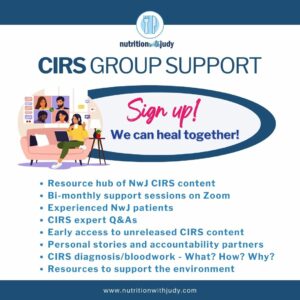

Pro-Tip: Are you looking for more in-depth practitioner resources and a like-minded community to support you through your CIRS journey? Join our exclusive CIRS Support Group for the latest research, step-by-step protocol tools, and support to successfully achieve root-cause healing.
Work With Our Trusted CIRS Practitioners
The Nutrition with Judy practice is honored to be a trusted CIRS practitioner support serving clients from around the globe. We’re passionate about helping our clients achieve root-cause healing in order to lead the best quality of life possible that’s nearly symptom-free. Our team is dedicated to finding the answers our patients need. We welcome you to explore our free resources and are always available to support you through personalized protocols. If you’re interested in working one-on-one with our CIRS nutritional therapy team to support you through your journey, our CIRS Support Package delivers the support and accountability for achieving root-cause healing.
Start your root-cause healing journey today and contact us any time with any questions or concerns.
DISCLAIMER: This content is for educational purposes only. While we are board-certified in holistic nutrition and are nutritional therapy practitioners, we are not providing medical advice. Whenever you start a new diet or protocol, always consult with your trusted practitioner first.


